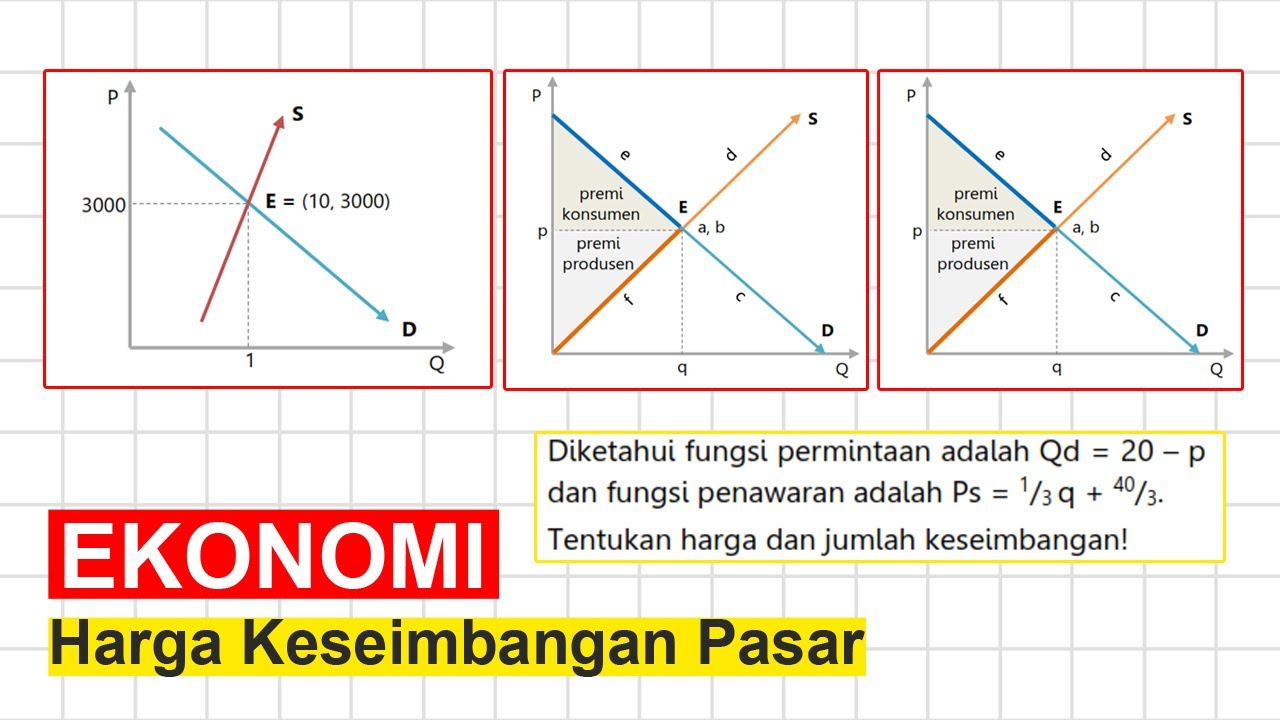Ekonomi Kelas 7 "Pasar"
Summary
TLDRThe transcript discusses the concept of markets in economics, emphasizing the interaction between buyers and sellers to reach an agreed price, known as the equilibrium price. It explains the essential conditions for a market, such as the presence of buyers, sellers, and goods or services. The video also covers the functions of markets, including distribution, price formation, and promotion. Furthermore, it outlines how markets contribute to the economy by benefiting consumers, producers, and economic development. The types of markets are explored, including concrete and abstract markets, as well as those based on the goods traded and the frequency of their occurrence.
Takeaways
- 😀 Markets are defined in economics as the process of interaction between sellers and buyers to reach an agreed price, not just a physical place.
- 😀 There are four key conditions for a market to exist: sellers, buyers, goods or services, and an agreed price.
- 😀 The functions of markets in the economy include distribution (helping goods flow from producers to consumers), price formation (establishing agreed prices), and promotion (introducing goods or services to the market).
- 😀 A market plays a critical role in the economy by benefiting consumers, producers, and economic development, including reducing unemployment by providing job opportunities.
- 😀 For consumers, markets provide easier access to needed goods and services, such as fresh produce, without needing to go directly to producers.
- 😀 For producers, markets offer a place to sell goods and services and introduce their products to a wide customer base.
- 😀 The government benefits from markets through taxes and retribution fees collected from goods sold, which contribute to state revenues.
- 😀 Markets are classified by their physical form: concrete markets (where transactions happen face-to-face) and abstract markets (like the stock market, where transactions occur without direct interaction).
- 😀 The key differences between concrete and abstract markets include visibility, direct transactions, and the ability to immediately obtain products in concrete markets versus waiting for delivery in abstract markets.
- 😀 Markets can also be categorized based on the type of goods being traded, such as consumer goods markets (e.g., food, clothing) and production goods markets (e.g., raw materials, machinery).
- 😀 Markets are organized based on time intervals, such as daily, weekly, monthly, or annual markets, with examples including daily markets, weekly markets like those for fresh produce, or annual events like fairs or trade expos.
Q & A
What is the general definition of a market according to the transcript?
-A market, in general, refers to a place where sellers and buyers meet to conduct transactions involving goods or services. It is focused on the physical location where the exchange occurs.
How does the economic definition of a market differ from the general definition?
-In economics, a market is defined as the process of interaction between sellers and buyers to establish an agreed-upon price. It emphasizes the interaction and process rather than just the physical location.
What are the four key requirements for the formation of a market?
-The four key requirements are: 1) A seller, 2) A buyer, 3) Goods or services being traded, and 4) The establishment of an agreed-upon price.
What are the primary functions of a market as described in the script?
-The primary functions of a market are: 1) Distribution function - to facilitate the flow of goods or services from producers to consumers, 2) Price formation function - to create an agreed-upon price, and 3) Promotional function - to introduce and inform about goods or services.
How does the market benefit consumers?
-Markets benefit consumers by providing easier access to goods or services that meet their needs. For example, consumers can purchase goods like vegetables from markets without needing to go directly to their producers.
What role does the market play for producers?
-For producers, markets serve as a platform to introduce and sell their goods to consumers. Producers do not need to meet every individual consumer but can use the market to facilitate the distribution of their products.
How does the market contribute to economic development?
-Markets contribute to economic development by generating government revenue through taxes and retributions, reducing unemployment by creating job opportunities, and supporting the growth of the economy.
What is the difference between concrete (real) markets and abstract (non-real) markets?
-Concrete markets are physical places where buyers and sellers meet, and goods are exchanged directly, like local markets. Abstract markets, on the other hand, are virtual or conceptual, such as the stock market, currency exchange markets, and labor markets, where transactions occur without direct physical interaction.
What are examples of concrete markets mentioned in the transcript?
-Examples of concrete markets include Pasar Tanah Abang in Jakarta, Pasar Ubud in Bali, and Pasar Petisah in Medan, where physical goods are exchanged directly between buyers and sellers.
What is the key difference in the payment methods between concrete and abstract markets?
-In concrete markets, payments are usually made in cash or directly at the point of sale. In abstract markets, payments are typically made through electronic transfers, such as via bank transfers or online payment systems.
Outlines

This section is available to paid users only. Please upgrade to access this part.
Upgrade NowMindmap

This section is available to paid users only. Please upgrade to access this part.
Upgrade NowKeywords

This section is available to paid users only. Please upgrade to access this part.
Upgrade NowHighlights

This section is available to paid users only. Please upgrade to access this part.
Upgrade NowTranscripts

This section is available to paid users only. Please upgrade to access this part.
Upgrade Now5.0 / 5 (0 votes)





